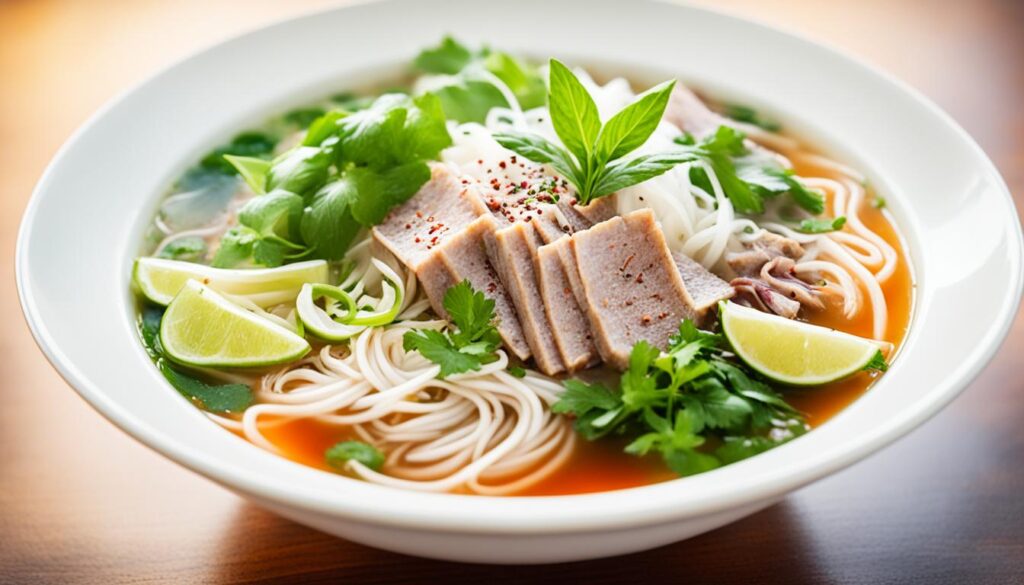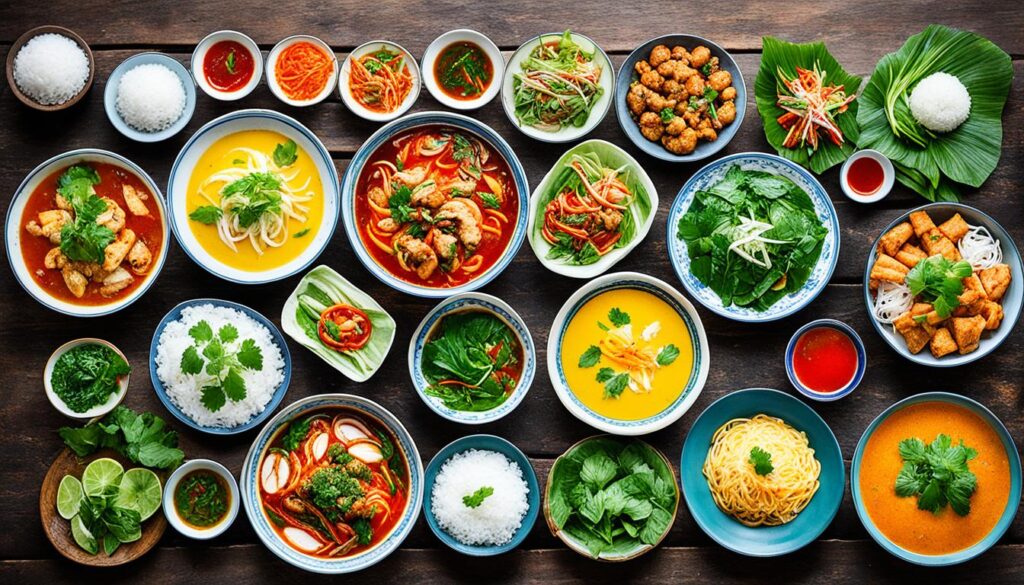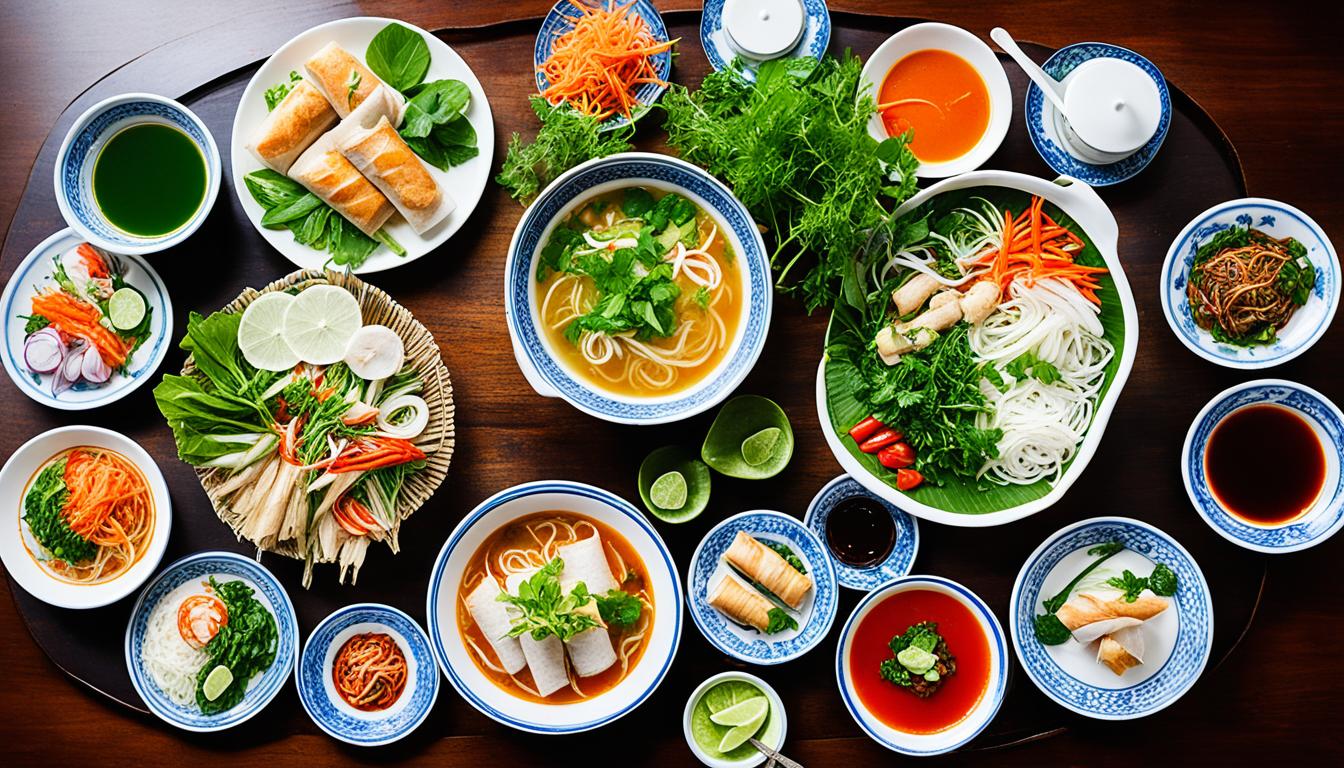Have you ever wondered what makes Vietnamese food so incredibly delicious and unique? Is it the tantalizing blend of flavors? The use of fresh herbs and spices? Or perhaps the harmonious balance of taste and texture? In this comprehensive guide, we will delve into the world of Vietnamese cuisine, exploring its vibrant flavors, traditional dishes, and rich food culture. Get ready to embark on a culinary journey that will leave your taste buds craving for more!
Key Takeaways
- Vietnamese cuisine is a fusion of Chinese, French, and Indian influences, resulting in a unique culinary experience.
- Traditional dishes like phở, bánh mì, and gỏi cuốn showcase the diversity and flavors of Vietnamese food.
- Rice, rice noodles, and rice paper are staples in Vietnamese cuisine, adding texture and versatility to dishes.
- Each region in Vietnam has its own distinctive dishes and flavors, offering a diverse culinary experience.
- Immerse yourself in Vietnamese food culture by trying authentic recipes at home or exploring the best Vietnamese restaurants.
Exploring Vietnamese Staples: Rice, Noodles, and Wrappers
In Vietnamese cuisine, rice is a fundamental staple that is prominently featured in various dishes. Whether it’s fragrant white rice or broken rice grains, rice serves as the foundation of many Vietnamese meals. Its versatility allows it to be used in various preparation methods, from steaming and stir-frying to making rice noodles and paper.
Rice noodles, known as bánh phở, are a ubiquitous addition to iconic Vietnamese soups like phở and bún bò Huế. These delicate and silky noodles come in different shapes and sizes, adding a textural element to the dishes they accompany. Whether thin or wide, these rice noodles contribute to the richness and depth of flavor in these beloved Vietnamese classics.
“Rice paper, or bánh tráng, is a versatile ingredient used to wrap various ingredients in Vietnamese dishes like spring rolls and banh xeo.”
Bánh tráng, or rice paper, is another essential component of Vietnamese cuisine. These thin, translucent sheets of dried rice play a crucial role in dishes like fresh spring rolls and savory banh xeo. Rice paper provides a delicate and satisfying texture that houses a medley of ingredients, offering a delightful balance of flavors. It is a staple in Vietnamese households and renowned for its unique texture and mildly sweet taste.
Exploring the diverse world of Vietnamese cuisine reveals the significance of rice, rice noodles, and rice paper in creating traditional dishes. These staples form the backbone of many beloved Vietnamese meals, offering a distinct cultural experience through their flavors, textures, and versatility.
Traditional Vietnamese Dishes: Pho, Banh Mi, and More
When it comes to traditional Vietnamese dishes, there are a few iconic favorites that you must try. These dishes showcase the unique flavors and cultural heritage of Vietnamese cuisine. From the famous pho to the delicious banh mi, Vietnamese street food offers a wide range of flavors and textures.

Pho is undoubtedly the star of Vietnamese cuisine. This aromatic noodle soup has gained popularity not only in Vietnam but also around the world. The soulful broth, tender rice noodles, and a variety of toppings like thinly sliced beef, chicken, or even tofu make pho a comforting and satisfying meal. Originating in Northern Vietnam, pho has become a beloved dish throughout the country.
Banh Mi:
Next on the list is the famous banh mi, a Vietnamese sandwich that perfectly embodies the fusion of Vietnamese and French culinary influences. This delightful creation features a crusty baguette filled with a combination of meats like pork, pate, or grilled chicken, complemented by pickled vegetables, fresh herbs, and a spread of mayonnaise or butter. The result is a harmonious blend of flavors and textures that will leave you craving for more.
Vietnamese Street Food:
While pho and banh mi are well-known dishes, Vietnamese street food offers a whole world of culinary delights to explore. From crispy banh xeo (Vietnamese crêpe) to bún chả (grilled pork with rice vermicelli), every street corner in Vietnam presents a new and exciting taste experience. The vibrant street food culture of Vietnam allows you to savor unique dishes like ốc (snails) cooked in various styles, each boasting its own distinctive flavors.
“Vietnamese street food is a must-try, with its diverse range of dishes showcasing the bold flavors and culinary creativity of the Vietnamese people.”
To help you envision the variety of traditional Vietnamese dishes and street food, here is a table highlighting some notable examples:
| Dish | Description |
|---|---|
| Banh Xeo | A crispy Vietnamese crêpe filled with bean sprouts, pork, and shrimp, often served with fresh herbs and dipping sauce. |
| Bún Chả | A popular dish featuring grilled pork served with rice vermicelli noodles, fresh herbs, and a flavorful dipping sauce. |
| Ốc | A variety of snail dishes prepared in different ways, such as sautéed with lemongrass and chili or stir-fried with garlic butter. |
Exploring the traditional Vietnamese dishes and street food is a delightful way to immerse yourself in the flavors and culinary traditions of Vietnam. Each bite is a sensory adventure, offering a glimpse into the rich food culture of the country.
Regional Variation: North, Central, and South Vietnam
Vietnam’s regional cuisine is a testament to the country’s diverse culinary heritage. Each region offers unique flavors and dishes that are representative of its local ingredients and cultural influences. Let’s take a closer look at the distinct culinary identities of Northern, Central, and Southern Vietnam.
1. Northern Vietnam
In Northern Vietnam, with Hanoi as its capital, the cuisine is known for its simplicity and bold yet delicate flavors. Pho, a fragrant rice noodle soup, is a staple of this region and a beloved dish throughout the country. It is often enjoyed for breakfast or as a comforting meal during cooler weather. Other popular dishes include bun cha (grilled pork with rice noodles) and cha ca (turmeric-marinated fish served with noodles and herbs).
2. Central Vietnam
Central Vietnam, particularly the city of Hoi An, boasts a culinary style influenced by Chinese, Japanese, French, and Vietnamese cuisines. The region is renowned for dishes like cao lau, a flavorful noodle dish made with marinated pork, pork crackling, and crisp greens. Another iconic dish is banh xeo, a savory pancake filled with shrimp, pork, bean sprouts, and herbs. Central Vietnamese cuisine is characterized by its bold flavors and unique combinations of ingredients.
3. Southern Vietnam
Southern Vietnam, centered around Ho Chi Minh City, embraces a vibrant and diverse culinary scene. The cuisine of this region is influenced by its lush agricultural land and abundant waterways. Fresh vegetables, herbs, seafood, and tropical fruits feature prominently in Southern Vietnamese dishes. Banh mi, a Vietnamese-French sandwich filled with various meats, pate, pickled vegetables, and fresh herbs, is a popular street food in this region. Bun cha, a dish consisting of grilled pork, vermicelli noodles, herbs, and a flavorsome dipping sauce, is also a favorite among locals and visitors alike.
Exploring the regional cuisines of Vietnam is a delightful journey that allows you to savor the country’s diverse flavors and culinary traditions. Whether you’re captivated by the simplicity of Northern Vietnamese dishes, the fusion of flavors in Central Vietnam, or the fresh and vibrant cuisine of Southern Vietnam, each region offers a unique culinary experience that is sure to tantalize your taste buds.

Conclusion
Vietnamese cuisine offers an exciting culinary journey filled with the vibrant flavors, fresh ingredients, and diverse dishes. Whether you’re exploring the street food stalls of Hanoi or dining at a top-notch restaurant in Ho Chi Minh City, you’ll be captivated by the authentic flavors and cultural richness of Vietnamese food.
To fully immerse yourself in Vietnamese cuisine, we encourage you to try cooking authentic recipes at home. There’s nothing quite like the satisfaction of creating your own delicious Vietnamese dishes, and there are plenty of authentic Vietnamese recipes available online to guide you.
If you prefer to leave the cooking to the experts, make sure to seek out the best Vietnamese restaurants in your area. These establishments offer a taste of Vietnam’s culinary heritage, serving up traditional dishes with the perfect balance of flavors. From aromatic pho bowls to mouth-watering banh mi sandwiches, you’re in for a treat.
For further inspiration and insights into Vietnamese cuisine, consider exploring a Vietnamese food blog. These online resources not only provide authentic recipes but also share stories, tips, and recommendations from experienced food enthusiasts. They are a treasure trove of information for anyone passionate about Vietnamese food.
